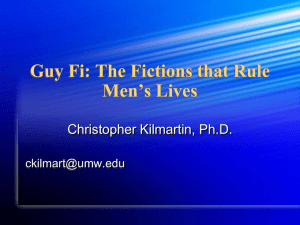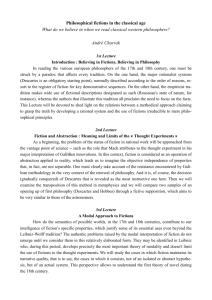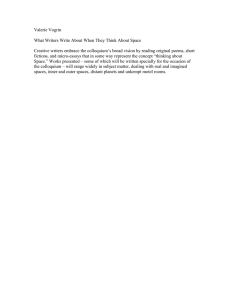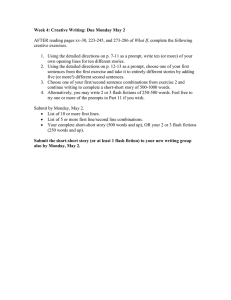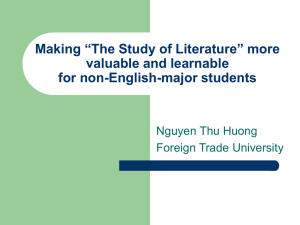jeto específico de otra u otras publicaciones semejantes a la
advertisement
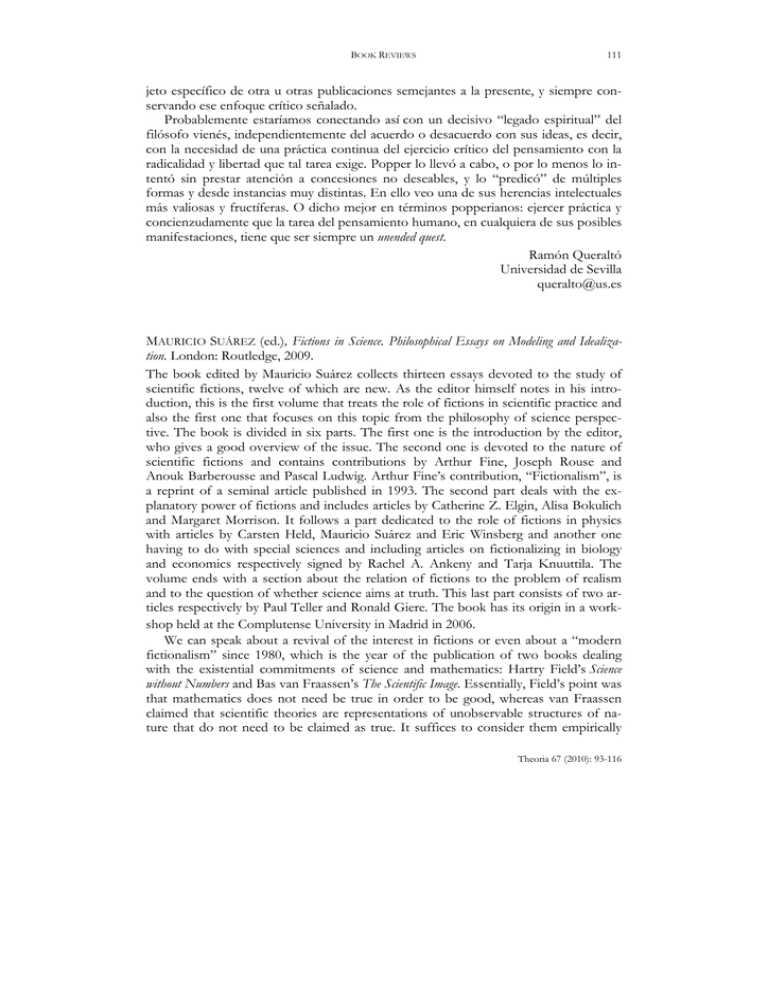
BOOK REVIEWS 111 jeto específico de otra u otras publicaciones semejantes a la presente, y siempre conservando ese enfoque crítico señalado. Probablemente estaríamos conectando así con un decisivo “legado espiritual” del filósofo vienés, independientemente del acuerdo o desacuerdo con sus ideas, es decir, con la necesidad de una práctica continua del ejercicio crítico del pensamiento con la radicalidad y libertad que tal tarea exige. Popper lo llevó a cabo, o por lo menos lo intentó sin prestar atención a concesiones no deseables, y lo “predicó” de múltiples formas y desde instancias muy distintas. En ello veo una de sus herencias intelectuales más valiosas y fructíferas. O dicho mejor en términos popperianos: ejercer práctica y concienzudamente que la tarea del pensamiento humano, en cualquiera de sus posibles manifestaciones, tiene que ser siempre un unended quest. Ramón Queraltó Universidad de Sevilla queralto@us.es MAURICIO SUÁREZ (ed.), Fictions in Science. Philosophical Essays on Modeling and Idealization. London: Routledge, 2009. The book edited by Mauricio Suárez collects thirteen essays devoted to the study of scientific fictions, twelve of which are new. As the editor himself notes in his introduction, this is the first volume that treats the role of fictions in scientific practice and also the first one that focuses on this topic from the philosophy of science perspective. The book is divided in six parts. The first one is the introduction by the editor, who gives a good overview of the issue. The second one is devoted to the nature of scientific fictions and contains contributions by Arthur Fine, Joseph Rouse and Anouk Barberousse and Pascal Ludwig. Arthur Fine’s contribution, “Fictionalism”, is a reprint of a seminal article published in 1993. The second part deals with the explanatory power of fictions and includes articles by Catherine Z. Elgin, Alisa Bokulich and Margaret Morrison. It follows a part dedicated to the role of fictions in physics with articles by Carsten Held, Mauricio Suárez and Eric Winsberg and another one having to do with special sciences and including articles on fictionalizing in biology and economics respectively signed by Rachel A. Ankeny and Tarja Knuuttila. The volume ends with a section about the relation of fictions to the problem of realism and to the question of whether science aims at truth. This last part consists of two articles respectively by Paul Teller and Ronald Giere. The book has its origin in a workshop held at the Complutense University in Madrid in 2006. We can speak about a revival of the interest in fictions or even about a “modern fictionalism” since 1980, which is the year of the publication of two books dealing with the existential commitments of science and mathematics: Hartry Field’s Science without Numbers and Bas van Fraassen’s The Scientific Image. Essentially, Field’s point was that mathematics does not need be true in order to be good, whereas van Fraassen claimed that scientific theories are representations of unobservable structures of nature that do not need to be claimed as true. It suffices to consider them empirically Theoria 67 (2010): 93-116 112 BOOK REVIEWS adequate. According to this, and as Kalderon has recently put it in his book Fictionalism in Metaphysics, fictionalism is the position holding that acceptance in a given domain of inquiry need not be truth-normed and that the acceptance of a sentence from that domain need not involve belief in its content. Certain theses and positions (or their interpretations) during the history of philosophy and the history of science can be considered more or less clear forms of fictionalism: Kant’s account of the ideas of reason, Nietzsche’s remarks on the “errors necessary for life”, Duhem’s instrumentalism and, above all, Jeremy Bentham’s theory of fictions and Hans Vaihinger’s philosophy of the “as if”. More recently, it has deserved an increasing attention in philosophy and different fictionalist accounts in philosophy of science, ethics, metaphysics and philosophy of mathematics have been proposed. The book edited by Kalderon is a good example of this revival. But, until the publication of Suárez’s volume, there were no compilations or monographs on this issue in the philosophy of science literature. Now, thanks to this effort, we have a collection of new essays focusing on fictions and their relation to scientific modeling and inquiry, which will surely be a reference work for the next several years. As we have said above, the first article of Fictions in Science is a reprint of a seminal essay by Arthur Fine which has been a landmark for the subsequent debate on scientific fictions. Fine’s paper is basically a reexamination of Vaihinger’s philosophy of “as if” by contrasting it with the logical positivism of the Vienna Circle and later, postpositivist approaches to scientific fictions. Despite some historical inaccuracies, Fine’s interpretation “lays out the connection between fictions and the contemporary philosophical literature on modeling practice more carefully and helpfully than Vaihinger would have been able to do.” (p. 5). According to Fine’s analysis, Vaihinger’s fictionalism was an important effort to make us aware of the central role of model building, simulation and other constructive techniques and, by despising it, logical positivists were unable to recognize this. It follows an article by Joseph Rouse, emphasizing not only the role of fictions in scientific theorizing and model building, but also in laboratory practices. Rouse takes a step forward by considering experimental systems as materialized fictional “worlds” that are integral to scientific conceptualization and, by doing so, he is setting the basis for a radical new approach that deserves much attention. Barberousse and Ludwig address the ontological question of what are scientific models and their answer is that models are fictions or more exactly representations of fictional situations. They also provide an analysis of the relationships between fiction, imagination and scientific practice within a representational framework, following the work of authors like Currie and Walton in their analysis of the role of fictions in scientific practice. By attempting to give an account of scientific representation and its explanatory role, Elgin resorts to the Goodmanian notion of exemplification of properties that does not require of actual denotation. According to this, a scientific model is a representation or denoting symbol that has an ostensible subject and portrays it as exemplifying certain features. This account would elude a number of controversies that have arisen in recent discussions about scientific models. For Bokulich the explanatory role of fictions has so many specificities that a new model of explanation, distinct from the previous ones, is needed. Model explanations could be characterized Theoria 67 (2010): 93-116 BOOK REVIEWS 113 as those that make essential reference to idealizing models that account for a certain counterfactual dependence. Different types of model explanation can then be distinguished, each having their own justificatory role. According to this, fictions are intimately linked to idealization, but, according to Morrison, in order to give an appropriate account of the explanatory role of scientific representation, we should distinguish fictions both from idealizations and abstractions. Fictional models would be those that are deliberately intended as imaginary or falsified accounts of the representandum. She exemplifies this by taking Maxwell’s ether models as a case study. Like Winsberg’s, her contribution may count as an objection to Vaihinger’s “ubiquity of fictions” claim. The articles of parts IV and V deal with fictions in particular sciences. Held’s article focuses on the question whether (physical) theories describe reality and he arrives at the conclusion that theories are dynamical entities in the sense that we can take different attitudes toward them. This attitude is not still present when scientists show the explanatory success of a theory. We cannot claim to describe anything real at this level. Within an inferentialist conception of scientific representation, Suárez provides an account of Vaihinger’s typology of scientific fictions and argues in favour of the notion of full fiction (one involving self-contradiction) that most critics believed to be impossible (he exemplifies this with the case of quantum measurement). Winsberg tries to reconcile the recognized usefulness of fictional representations with the idea that science aims at truth or some surrogate. According to him, fictions ―understood as deliberate falsifications that do not aim at truth or reliability but that are very helpful because of their heuristic fruitfulness― are perhaps not so common than other forms of representation but equally central to scientific activity. He illustrates this with the case of simulation in physics, more specifically with the notion of artificial viscosity. Fictions seem to be a usual and powerful device in physics, but their use in special sciences is central too. Ankeny undertakes a revision of the literature on model organisms in biology attempting to show that different kinds of model organisms, like the fruitful Drosophila melanogaster, display all the features of scientific fictions to some degree. She emphasizes their explanatory power as well as their relative character. On the other hand, Knuttila faces up the crucial problem of the realisticness of economic models and tries to answer by taking models as autonomous and independent tools that can only represent indirectly. Precisely, the two last articles of the volume deal with the problem of realism. In the use of fictions, Teller does not see any obstacle for being the truth (or approximative truth) the aim of science. Scientific models do in fact contain idealizations as well as approximations. Relative to possible interests in distorted aspects of a component idealization or approximation, the idealization or approximation would count as a fiction. Relative to interests for which the model produces enough accurate descriptions, the model would count as veridical. Like Teller, Giere argues that models should better not be identified with fictions, but it must be said that the identification of models and fictions is not the general message of the book either, but only that fictionalizing is an essential part of scientific activity (theoretical or practical). Theoria 67 (2010): 93-116 114 BOOK REVIEWS To sum it briefly, Suárez’s volume is an important contribution to the philosophy of science literature and will be considered an unavoidable reference not only for the debate on the nature and function of scientific fictions, but also for the study of models and idealization in science. Xavier de Donato Universidad de Santiago de Compostela xavier_donato@yahoo.com ROBERTO TORRETTI (ed.), Conceptos de Gen. Santiago de Chile: Ediciones Universidad Diego Portales, 2008. Charles Darwin se las vio y se las deseó para configurar una teoría de la herencia que fuera empíricamente adecuada a sus tiempos e ideas, lo mismo sucedió con su famoso primo Francis Galton y, sobre todo, con el ingeniero, biomatemático e importante filósofo de la ciencia Karl Pearson por mencionar tres personajes principales en el contexto decimonónico británico. De hecho, el mismo Gregor Johann Mendel, el padre de la genética, tuvo dificultades insuperables para generalizar sus por otra parte excelentes resultados obtenidos con guisantes. Pero el concepto de gen en un sentido lato (partícula/factor hereditario) se fue abriendo paso al iniciarse el siglo XX con Hugo de Vries y otros. Especialmente el gen se aceptó mayoritariamente después de que Thomas Hunt Morgan y su equipo confirmaran su existencia operacional (mapas genéticos) que sin embargo quedaba como hipotética a la hora de interpretar múltiples resultados en principio discordantes. Pero a medida que avanzaba el siglo XX el preciado gen perdía fuerza explicativa a la par que la complejidad orgánica en que radicaba la herencia se iba apreciando en toda su magnitud, de manera que la dicotomía herencia (genotipo, genoma) x medio (lo que no se hereda) resultaba demasiado simplista. Esta circunstancia se constata muy claramente en la soberbia colección de artículos que nos ocupa. El compilador ha seleccionado siete textos significativos al respecto, seis de ellos escritos en torno al año 2000 desde una perspectiva propiamente epistémica y un escrito desde una vertiente metodológica que actúa de cabecera. La perspectiva general que se ofrece es epigenética, es decir, desde una especie de tierra de nadie entre el genoma y el medio donde en cualquier caso se demuestra que la nitidez primero de la expresión 1 gen-1 carácter y luego de 1 gen-1 enzima queda desvirtuada por una realidad mucho más compleja en que, por ejemplo, los conceptos de información y código genético se convierten en el mejor de los casos en metáforas poco realistas “para ir tirando” y no romper demasiado abruptamente con un pasado en que todo iba quedando gradualmente claro. La historia de la genética es claramente la historia de una frustración aunque sea para bien. Como estipula en un primer escrito Raphael Falk, ya en los años 60 al dirigirse “gran parte de la atención al ADN eucariótico, fue necesario acomodar el gen a una creciente avalancha de descubrimientos que no calzaba con el concepto de una idea Theoria 67 (2010): 93-116
